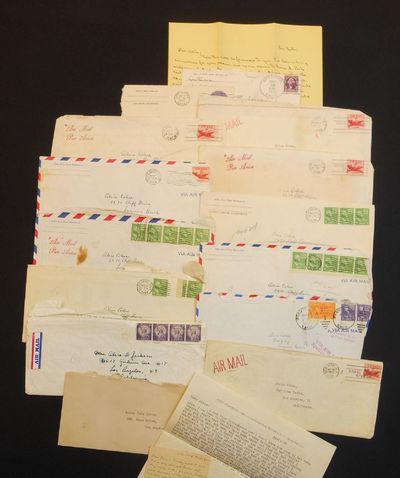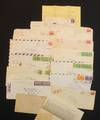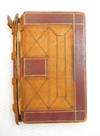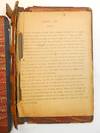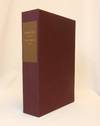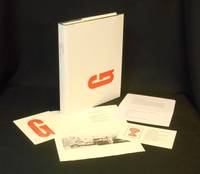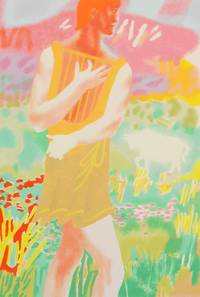signed Leather bound
1933 · n.p.
by Steinbeck, John
n.p.: John Steinbeck, 1933. Leather bound. Very good. Carbon copy of typescript, bound by Steinbeck for presentation to Alice Cohee, with archive of fifteen substantive letters from Steinbeck to Alice Cohee, and with fragment of destroyed book "Dissonant Symphony", in a custom box. "Tortilla Flat" was John Steinbeck's (1902-1968) breakthrough novel which would launch his successful literary career; he would ultimately be awarded the Pulitzer Prize for Fiction in 1940, and the Nobel Prize in Literature in 1962.
Prior to the publication of "Tortilla Flat" in 1933, Steinbeck had published three books, none of them successful, and he was failing at finding a publisher for his fourth, "Tortilla Flat". In the end it was Alice Cohee, a close friend, who urged Steinbeck to try one more time; this time Covici Friede took the book, launching his successful career (n.b., from "Carol and John Steinbeck: Portrait of a Marriage", by Susan Shillinglaw, p. 126). Alice was presented with the manuscript, this item being that manuscript (in reality a carbon copy of the typescript). According to a professional appraisal obtained by the Cohee family, "the typescript is a relatively late version of the text and includes the preface in its final form but does not include the chapter headings added after conversations with Elizabeth Otis and Pat Covici" (ibid). The typescript with a few holographic corrections in an unknown hand, possibly that of Steinbeck's wife at the time, Carol Henning, who served as his typist, along with a "few differences from the published text".
The typescript is bound in a folio-size ledger book by Steinbeck himself. The ledger book was probably used by Steinbeck for other purposes before he used it to bind the typescript, which was drilled or stabbed twice with two wing clamps inserted through the entire typescript. The front cover of the ledger has the title written in bold letters at the top; in the middle "For John & Alice Cohee", with Steinbeck's signature at the bottom, this in what is undoubtedly his handwriting. On the verso of the front board is a paper label with the hand-written note: "This is one of a first edition of two copies of which this is #2". It is unknown what happened to #1, one could surmise it was given to his wife, Carol. At the top of the back board is written "Phalanx"; "Tortilla Flat" is one of several of his books in which Steinbeck utilizes his "Phalanx Theory", in which a group of men operate far differently than an individual. Also written on the back board is "The old colection (sic) of Doodads" (unsure, this our best rendering).
What many of Steinbeck's fans may not be aware of is that prior to "Tortilla Flat" he had written another novel, "Dissonant Symphony". However, Steinbeck was so unhappy with the work that he destroyed the manuscript (according to his biographer, Jack Benson). It is fascinating that a page from the destroyed typescript for "Dissonant Symphony" is found on the verso of p. 3 of this typescript for "Tortilla Flat". Why it was used thus we will never know, but it is very likely the sole survivor of that work.
Offered along with the typescript is an archive of fifteen letters from Steinbeck to the recipient, Alice Cohee, none of which were published in "Steinbeck: A Life in Letters" (pub. 1975). It appears that there are no letters to Mrs. Cohee housed at the Humanities Research Center at the University of Texas or at Stanford University. Of the fifteen letters, twelve are autograph letters signed (usually "John", occasionally simply "J"), two are typed letters signed ("John"), one is a typed letter with the "John" also typed; in addition to the fifteen letters is one autographed postcard signed. The letters span from May 8, 1938 through March, 1953. The letters are substantive and long; eight letters with between 100 and 300 words, the others being 450, 600, 650, 950, 1400, and 1500 words. Eight of the fifteen letters are from the second half of the year 1948, a critical time in Steinbeck's life, including the death of his friend Ed Ricketts and request for divorce from his second wife, Gwyn.
No use of these letters has been made by scholars, in fact, few other than Cohee family members have read the letters. In them Steinbeck writes about his work, recent or projected travels, his living situation, state of mind, his health, repairs to the Pacific Grove house, personal matters/relationships with Gwyn, Elaine (his third wife), Ed Ricketts and Dook Sheffield (Carlton "Dook" Sheffield was Steinbeck's Stanford roommate and long time friend), people with whom he has been working (Elia Kazan), sometimes he writes about himself as a father, in some he writes about aging, life and death, social concerns such as migrant labour, nuclear weapons testing, and overpopulation. At times the letters are blunt about Alice's life and mental state, sometimes contrasting hers with his own, which shows his closeness to her.
A few excerpts (full transcripts available to serious inquiries): in the May 18, 1938 letter Steinbeck writes, "I've been out in the fields [working]...very terrible...Makes you ashamed to eat when it doesn't make you murderous"; in the May 28, 1948 letter he writes, "Ed [meaning Ed Ricketts] was the most selfish man I have ever known, but by being that he could be the kindest and most associative and open. We, and I mean you and me and nearly everyone I know of the little confused failure in the world think they are being selfless when they are simply afraid...; in the September 12, 1948 postcard he writes, "As for the break up -- I didn't leave, I was pushed. The fog smells so good it makes me a little crazy. It is going to be my seat for some time to come. He describes his letter of November 17, 1948 as "rough" since his discussion of her is on the pointed side. He mentions Carlton Sheffield (per the online archive of California Sheffield was "a friend and Stanford roommate of...John Steinbeck. He continued his friendship with Steinbeck after their college years and throughout his writing career through correspondence with Steinbeck and his wife") in his December 21, 1948 letter, stating "he has not changed very much". He turns down Alice's suggestion of her driving to see him in the May 21, 1949 (?) letter because he is busy at work and because of demands on this time; his "no" is rather detailed, writing in part, "I'm sorry Alice but I just refuse to be deflected even for one hour". The last letter is dated May 3, 1953; it is lengthy and detailed, covering nuclear weapons testing and his big Mallory project.
A unique offering with letters offering rich opportunities for further study, one of two typescript copies bound by Steinbeck himself (and perhaps the sole surviving copy of those he bound), with the likely sole extant fragment from "Dissonant Symphony".
___DESCRIPTION: Carbon copy of the typescript for "Tortilla Flat", bound into a previously-used ledger binding by Steinbeck himself (see full description above), the binding being of strips of gilt-tooled morocco inset with tan suede, marbled endpapers, with the single page of "Dissonant Symphony" (p. 118) on the verso of p. 3 of the typscript for "Tortilla Flat". Included is an archive of fifteen letters from Steinbeck to Alice Cohee, a friend of both Steinbeck and Ed Ricketts (per "Renaissance Man of Cannery Row, The Life and Letters of Edward F. Ricketts" by Katharine A. Rodgers) along with one autograph postcard (see fuller description of the letters above). Both the ledger and the letters housed in a custom box with the ledger above a tray containing the letters.
___CONDITION: Please note that we have graded this archive in its entirety as "Very Good", please read the following carefully for details. Ledger binding: in poor condition, the front board detached, a portion of the spine almost detached, substantial wear to edges. Typescript: the inexpensive paper now brown and somewhat brittle (particularly the first about half-dozen leaves, the first two leaves detached and with substantial edgewear; the typescript has been collated and is complete (please note that there is no page no. 203, however, the text reads continuously from p. 202 to 204). Letters: the letters themselves range between very good and near fine as they have all been stored inside of their envelopes, which are mostly in good condition only. The custom box fine, newly made.
___POSTAGE: International customers, please note the following: (i) additional postage may apply as the standard does not always cover costs, please inquire for details; and (ii) any taxes, duty, or tariffs charged by your country will, of necessity, be your responsibility.
___Swan's Fine Books is pleased to be a member of the ABAA, ILAB, and IOBA and we stand behind every book we sell. Please contact us with any questions you may have, we are here to help. (Inventory #: CNJD01)
Prior to the publication of "Tortilla Flat" in 1933, Steinbeck had published three books, none of them successful, and he was failing at finding a publisher for his fourth, "Tortilla Flat". In the end it was Alice Cohee, a close friend, who urged Steinbeck to try one more time; this time Covici Friede took the book, launching his successful career (n.b., from "Carol and John Steinbeck: Portrait of a Marriage", by Susan Shillinglaw, p. 126). Alice was presented with the manuscript, this item being that manuscript (in reality a carbon copy of the typescript). According to a professional appraisal obtained by the Cohee family, "the typescript is a relatively late version of the text and includes the preface in its final form but does not include the chapter headings added after conversations with Elizabeth Otis and Pat Covici" (ibid). The typescript with a few holographic corrections in an unknown hand, possibly that of Steinbeck's wife at the time, Carol Henning, who served as his typist, along with a "few differences from the published text".
The typescript is bound in a folio-size ledger book by Steinbeck himself. The ledger book was probably used by Steinbeck for other purposes before he used it to bind the typescript, which was drilled or stabbed twice with two wing clamps inserted through the entire typescript. The front cover of the ledger has the title written in bold letters at the top; in the middle "For John & Alice Cohee", with Steinbeck's signature at the bottom, this in what is undoubtedly his handwriting. On the verso of the front board is a paper label with the hand-written note: "This is one of a first edition of two copies of which this is #2". It is unknown what happened to #1, one could surmise it was given to his wife, Carol. At the top of the back board is written "Phalanx"; "Tortilla Flat" is one of several of his books in which Steinbeck utilizes his "Phalanx Theory", in which a group of men operate far differently than an individual. Also written on the back board is "The old colection (sic) of Doodads" (unsure, this our best rendering).
What many of Steinbeck's fans may not be aware of is that prior to "Tortilla Flat" he had written another novel, "Dissonant Symphony". However, Steinbeck was so unhappy with the work that he destroyed the manuscript (according to his biographer, Jack Benson). It is fascinating that a page from the destroyed typescript for "Dissonant Symphony" is found on the verso of p. 3 of this typescript for "Tortilla Flat". Why it was used thus we will never know, but it is very likely the sole survivor of that work.
Offered along with the typescript is an archive of fifteen letters from Steinbeck to the recipient, Alice Cohee, none of which were published in "Steinbeck: A Life in Letters" (pub. 1975). It appears that there are no letters to Mrs. Cohee housed at the Humanities Research Center at the University of Texas or at Stanford University. Of the fifteen letters, twelve are autograph letters signed (usually "John", occasionally simply "J"), two are typed letters signed ("John"), one is a typed letter with the "John" also typed; in addition to the fifteen letters is one autographed postcard signed. The letters span from May 8, 1938 through March, 1953. The letters are substantive and long; eight letters with between 100 and 300 words, the others being 450, 600, 650, 950, 1400, and 1500 words. Eight of the fifteen letters are from the second half of the year 1948, a critical time in Steinbeck's life, including the death of his friend Ed Ricketts and request for divorce from his second wife, Gwyn.
No use of these letters has been made by scholars, in fact, few other than Cohee family members have read the letters. In them Steinbeck writes about his work, recent or projected travels, his living situation, state of mind, his health, repairs to the Pacific Grove house, personal matters/relationships with Gwyn, Elaine (his third wife), Ed Ricketts and Dook Sheffield (Carlton "Dook" Sheffield was Steinbeck's Stanford roommate and long time friend), people with whom he has been working (Elia Kazan), sometimes he writes about himself as a father, in some he writes about aging, life and death, social concerns such as migrant labour, nuclear weapons testing, and overpopulation. At times the letters are blunt about Alice's life and mental state, sometimes contrasting hers with his own, which shows his closeness to her.
A few excerpts (full transcripts available to serious inquiries): in the May 18, 1938 letter Steinbeck writes, "I've been out in the fields [working]...very terrible...Makes you ashamed to eat when it doesn't make you murderous"; in the May 28, 1948 letter he writes, "Ed [meaning Ed Ricketts] was the most selfish man I have ever known, but by being that he could be the kindest and most associative and open. We, and I mean you and me and nearly everyone I know of the little confused failure in the world think they are being selfless when they are simply afraid...; in the September 12, 1948 postcard he writes, "As for the break up -- I didn't leave, I was pushed. The fog smells so good it makes me a little crazy. It is going to be my seat for some time to come. He describes his letter of November 17, 1948 as "rough" since his discussion of her is on the pointed side. He mentions Carlton Sheffield (per the online archive of California Sheffield was "a friend and Stanford roommate of...John Steinbeck. He continued his friendship with Steinbeck after their college years and throughout his writing career through correspondence with Steinbeck and his wife") in his December 21, 1948 letter, stating "he has not changed very much". He turns down Alice's suggestion of her driving to see him in the May 21, 1949 (?) letter because he is busy at work and because of demands on this time; his "no" is rather detailed, writing in part, "I'm sorry Alice but I just refuse to be deflected even for one hour". The last letter is dated May 3, 1953; it is lengthy and detailed, covering nuclear weapons testing and his big Mallory project.
A unique offering with letters offering rich opportunities for further study, one of two typescript copies bound by Steinbeck himself (and perhaps the sole surviving copy of those he bound), with the likely sole extant fragment from "Dissonant Symphony".
___DESCRIPTION: Carbon copy of the typescript for "Tortilla Flat", bound into a previously-used ledger binding by Steinbeck himself (see full description above), the binding being of strips of gilt-tooled morocco inset with tan suede, marbled endpapers, with the single page of "Dissonant Symphony" (p. 118) on the verso of p. 3 of the typscript for "Tortilla Flat". Included is an archive of fifteen letters from Steinbeck to Alice Cohee, a friend of both Steinbeck and Ed Ricketts (per "Renaissance Man of Cannery Row, The Life and Letters of Edward F. Ricketts" by Katharine A. Rodgers) along with one autograph postcard (see fuller description of the letters above). Both the ledger and the letters housed in a custom box with the ledger above a tray containing the letters.
___CONDITION: Please note that we have graded this archive in its entirety as "Very Good", please read the following carefully for details. Ledger binding: in poor condition, the front board detached, a portion of the spine almost detached, substantial wear to edges. Typescript: the inexpensive paper now brown and somewhat brittle (particularly the first about half-dozen leaves, the first two leaves detached and with substantial edgewear; the typescript has been collated and is complete (please note that there is no page no. 203, however, the text reads continuously from p. 202 to 204). Letters: the letters themselves range between very good and near fine as they have all been stored inside of their envelopes, which are mostly in good condition only. The custom box fine, newly made.
___POSTAGE: International customers, please note the following: (i) additional postage may apply as the standard does not always cover costs, please inquire for details; and (ii) any taxes, duty, or tariffs charged by your country will, of necessity, be your responsibility.
___Swan's Fine Books is pleased to be a member of the ABAA, ILAB, and IOBA and we stand behind every book we sell. Please contact us with any questions you may have, we are here to help. (Inventory #: CNJD01)
